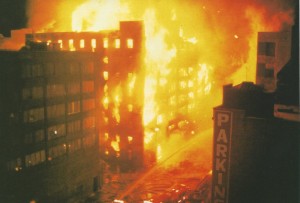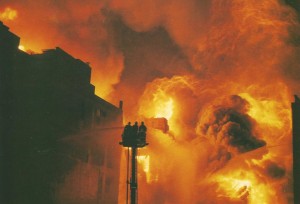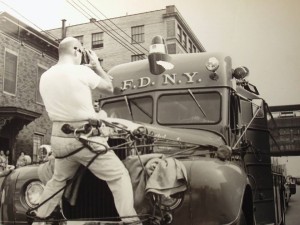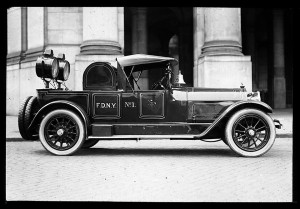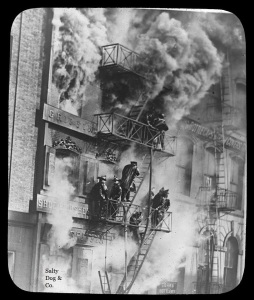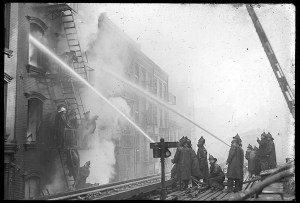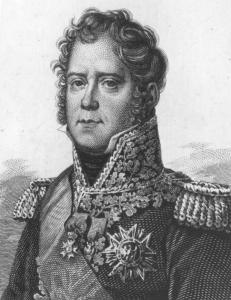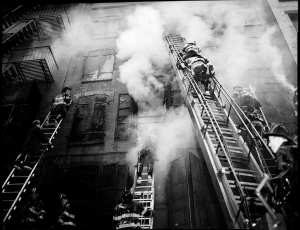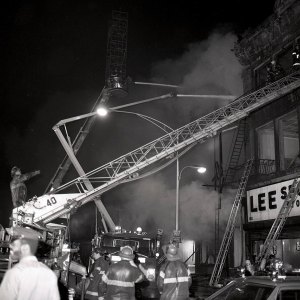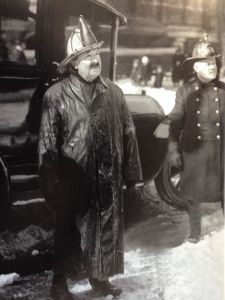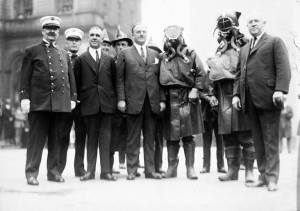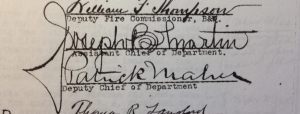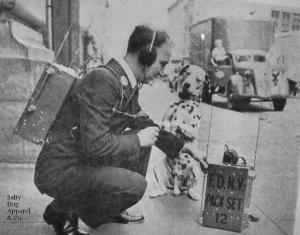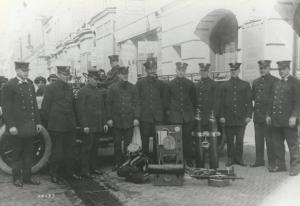From the Vault:
Spectacular photo by John Lee Gill of the 10-alarm fire that destroyed the quarters of Rescue 1 on Jan. 23, 1985 on West 43rd Street in Manhattan.. This was a verbal alarm transmitted by off-duty members of Rescue 1. Box 798 was transmitted at 1926 hours. At the fire’s height flames were venting out more than 80 windows. This 2nd shot was taken by Harvey Eisner, (a great friend, writer & photographer- miss you!) It shows the flames leaping from every window of the former piano factory. The building was 90 X 125-feet eight-stories high. That night the neighborhood truly was “Hell’s Kitchen!” Paul Hashagen
www.gettinsaltyapparel.com
Category Archives: History by Hashagen
FDNY Before Go Pro!
From the Vault: Before Go Pro!
Here is an interesting shot of an NBC camera man filming a Rescue 1 “response” for the Du Pont Show of the Week television series. The episode “Fire Rescue” aired on Sunday night September 30, 1962. The film crew shadowed the rescue firemen for three months and caught film of a huge 5-alarm fire in the Bond’s Clothing Store in Jamaica. (Rescue 4, 2 & 1 operated). Ah several Go Pros and suction cups would have gone a long way! www.saltydogapparel.com
Last “official” horse-drawn run FDNY
From the Vault:
1922 was a special year for the FDNY. All new apparatus being received were motorized, including two new Locomobiles equipped to operate as searchlight units. These rigs were purchased by Honorary Chiefs and donated to the department. The last “official” horse-drawn run would be made in December by Engine 205.
FDNY Fire 1915
From the Vault:
February 19, 1915 a two-alarm fire at Manhattan Box 22-665. 69 Murray Street. This snotty little job also trapped two traffic cops who’d evacuated the building but returned for a reported person left behind. The cops were rescued over FDNY ladders and returned to duty later that afternoon.
www.gettinsaltyapparel.com
Third Alarm Fire FDNY
This 3 alarm fire at Manhattan Box 99 occurred in the same area ravaged by the Great Fire of 1835 (where 600 buildings destroyed). This December 23, 1923 blaze was ignited by a pile of oily rags left by painters inside this eight-story building at 321 Pearl Street. The danger of the flames spreading was so great that Deputy Chief James Heffernan requested all apparatus south of Delancey Street to the scene. Due to the determined actions of the chief and his men the fire was contained. Firemen are seen here operating lines from the elevated subway tracks and working on fire escapes.
How FDNY got their Bravest nickname
New York’s Fire Department can trace their Bravest
nickname back to French military commander Michel Ney, the ‘bravest of the brave’
New York City’s smoke-eaters have earned their nickname a thousand times over since it was first applied to them in the late 1800s — but its origins may have more to do with the military than firefighting.
According to historians, the “bravest of the brave” was a Frenchman named Michel Ney, a fearsome and formidable foe on the battlefield who waged war alongside Napoleon from 1803 to 1815, during the Napoleonic Wars.
Ney was known to his troops as “Le Rougeaud,” or the red-faced one. But after one particularly daunting stretch of warfare, the Emperor dubbed him “le brave des braves.”
It might never have been attached to the FDNY if it weren’t for their brothers in blue, the NYPD.
As early as 1874, the city’s police force was being referred to as the “Finest,” according to historian and author Barry Popik.
The nickname is most commonly traced to Police Chief George Matsell, who once declared that he would make “the finest police force in the world.”
By the early 1880s, a play about cops titled “One of the Finest” cemented the name, Popik said. Not to be outdone, firefighters soon began referring to some of their most heralded members as the “Bravest.”
In 1862 a newspaper article saluted Capt. John Downey as “the bravest of the brave.”
In 1886, a play appeared about city firemen called “One of the Bravest” — which pretty much sealed it in the eyes of the public and among the rank-and-file.
Before long, city dwellers were lining up to buy tickets to what became annual baseball games between the “Finest” and the “Bravest,” Popik said.
FDNY Squirts
Smoky Joe Martin FDNY
When Joseph B. Martin joined the FDNY in 1884, he was one of the only firemen on the job with a college education. He rose quickly through the ranks. While in command of Engine 31 he would earn his now world famous nickname.
On a cold winter night in 1899 Martin led an attack on a dangerous cellar fire in a large warehouse. Despite the fact the nozzle teams had to keep changing men, Martin stayed at the lead. Man after man took his turn at the knob only to be driven from his position by the heavy smoke and high heat conditions. Soon his entire company was laid out in the street unconscious or gasping for air. After watching yet another company stumble out into the street, Chief Croker ordered everyone out.
Martin remained.
The chief crawled in himself. After three attempts to reach the nozzle the veteran chief finally found Martin, nozzle in hand wedged between packing crates battling the flames. Crocker grabbed him by the collar and pulled him out.
In the street, Croker announced, half-angry and half-proud “Gentlemen, this is Smoky Joe Martin. By the gods he certainly does love it!”
The nickname stuck.
The salty fire officer would continue up the ranks until he became Assistant Chief. Martin commanded some of the most dangerous and difficult fires any fire officer has ever faced. He continued leading his beloved men until he was forced to retire in November 1930. He died at home 11 years later.
In 1944, the now famous character “Smokey Bear” was named after him.
The photos show Martin with his driver “Daredevil Dan” Healy. Martin far left with smoke helmeted Rescue 1 men and the mayor at Medal Day 1916. And Martin’s ornate signature on a report from the Board of Merit. Paul Hashagen www.gettinsaltyapparel.com
Boots Fire Dog
From the photo vault:
This shot of Rescue 1 Capt. Raymond Millner with “Boots” a very salty dog, answers two questions.
1- How big was a portable radio in 1943? Answer- 13 -1/2 lbs.
2- Was “Boots” a girl or boy? Answer- obvious…
Paul Hashagen- author www.saltydogapparel.com #saltydog
Rescue 1 FDNY
From the Vault:
One Hundred Years Ago Today-
March 7, 1915 was a Sunday. The members of the FDNY’s newest unit Rescue Company 1 had the day off. They had just finished exhaustive training that started on January 19th. They mastered the use of the smoke helmets, cutting torches, pulmotors, block and tackle, bottle jacks and studied the operation and repair of large ammonia systems. The following day they would embark on a journey into uncharted waters. They would go where no other firemen had ever gone, and lived to talk about it.
They would crawl, or wade or walk into clouds of toxic smoke and gases. Pull unconscious firemen and civilians from water and carbon monoxide filled cellars and sub-cellars. They would plunge into the holds of ships with hose lines or swing on ropes to reach people trapped by flames.
The entire history of heavy & technical rescue, and hazardous materials operations can be directly traced back to one captain, a lieutenant and eight men that rolled out of a firehouse in lower Manhattan and started a branch of the fire service that is still growing today.
This new saga would begin tomorrow morning- 100 years ago.
Stay tuned!
